Inspire Education CHC30113 - Physical and Emotional Wellbeing Workbook
VerifiedAdded on 2023/06/06
|49
|10110
|158
Homework Assignment
AI Summary
This document is a completed workbook for the CHC30113 Certificate III in Early Childhood Education & Care, focusing on Subject 5: Physical and Emotional Wellbeing. It covers key aspects of providing care for children, including physical care, promoting physical activity, adapting facilities, helping children with change, and settling new arrivals. The workbook includes a knowledge assessment with short answer questions, case studies exploring practical scenarios, and references to the Australian Children’s Education & Care Quality Authority (ACECQA) and the Early Years Learning Framework (EYLF). The assessment explores topics such as the objectives of the National Quality Framework (NQF), the NQS quality areas, the aims and outcomes of the EYLF, and the professional responsibilities of early childhood professionals. The assessment also includes questions on children's sleep patterns and cues, and the appropriate responses to these cues. The assignment is designed to assess the student's understanding of the principles and practices of providing care for children's physical and emotional well-being in an early childhood setting, and also includes information on accessing intranet pages and external links relevant to the subject matter. The document is contributed by a student to be published on the website Desklib. Desklib is a platform which provides all the necessary AI based study tools for students.

CHC30113
Certificate III in Early
Childhood Education &
Care
Subject 5
Physical and Emotional
Wellbeing
Version 3.1 | Produced 06 July 2021
Copyright © Compliant Learning Resources 2016. This document was developed by Compliant Learning
Resources and has been edited and contextualised by Inspire Education RTO 32067 for its student cohorts
under license. All rights reserved. No part of this publication may be reproduced, stored in a retrieval
system or transmitted in any form or by any means electronic, mechanical, photocopying, recording or
otherwise without the prior written permission of Compliant Learning Resources.
Version control & document history
Certificate III in Early
Childhood Education &
Care
Subject 5
Physical and Emotional
Wellbeing
Version 3.1 | Produced 06 July 2021
Copyright © Compliant Learning Resources 2016. This document was developed by Compliant Learning
Resources and has been edited and contextualised by Inspire Education RTO 32067 for its student cohorts
under license. All rights reserved. No part of this publication may be reproduced, stored in a retrieval
system or transmitted in any form or by any means electronic, mechanical, photocopying, recording or
otherwise without the prior written permission of Compliant Learning Resources.
Version control & document history
Paraphrase This Document
Need a fresh take? Get an instant paraphrase of this document with our AI Paraphraser
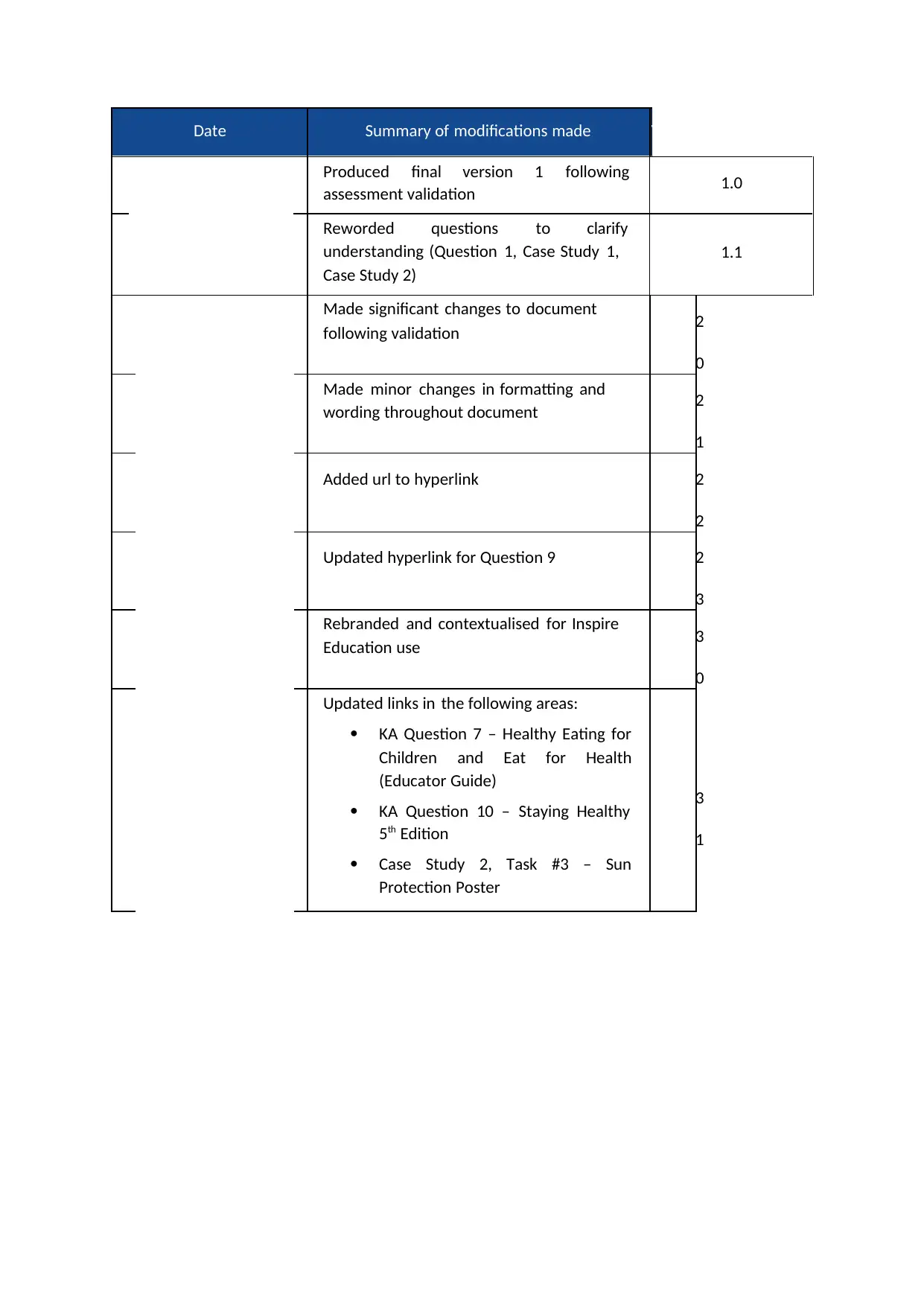
Date Summary of modifications made Version
Produced final version 1 following
assessment validation 1.0
Reworded questions to clarify
understanding (Question 1, Case Study 1,
Case Study 2)
1.1
Made significant changes to document
following validation 2
0
Made minor changes in formatting and
wording throughout document 2
1
Added url to hyperlink 2
2
Updated hyperlink for Question 9 2
3
Rebranded and contextualised for Inspire
Education use 3
0
Updated links in the following areas:
KA Question 7 – Healthy Eating for
Children and Eat for Health
(Educator Guide)
KA Question 10 – Staying Healthy
5th Edition
Case Study 2, Task #3 – Sun
Protection Poster
3
1
Produced final version 1 following
assessment validation 1.0
Reworded questions to clarify
understanding (Question 1, Case Study 1,
Case Study 2)
1.1
Made significant changes to document
following validation 2
0
Made minor changes in formatting and
wording throughout document 2
1
Added url to hyperlink 2
2
Updated hyperlink for Question 9 2
3
Rebranded and contextualised for Inspire
Education use 3
0
Updated links in the following areas:
KA Question 7 – Healthy Eating for
Children and Eat for Health
(Educator Guide)
KA Question 10 – Staying Healthy
5th Edition
Case Study 2, Task #3 – Sun
Protection Poster
3
1

This is an interactive table of contents. If you are viewing this document in Acrobat, you will
be directed to the page after clicking on a heading. If you have this document open in Word,
you will need to hold down Ctrl (for Windows) or Command ⌘ (for Mac) as you click on the
heading for the link to work.
INTRODUCTION TO THIS WORKBOOK.............................................................4
What is this workbook about?...............................................................................................4
Context for Assessment.........................................................................................................5
ABOUT THE ASSESSMENTS..............................................................................6
Assessment Methods.............................................................................................................6
Resources Required for Assessment......................................................................................6
INSTRUCTIONS TO STUDENT...........................................................................7
Accessing Intranet Pages and External Links.........................................................................7
ASSESSMENT WORKBOOK COVER SHEET........................................................8
KNOWLEDGE ASSESSMENT.............................................................................9
CASE STUDIES................................................................................................22
Instructions to Assessor.......................................................................................................22
Instructions to Student.........................................................................................................22
Case Study 1.........................................................................................................................23
Checkpoint........................................................................................................................27
Case Study 2.........................................................................................................................28
Checkpoint........................................................................................................................31
EVIDENCE TO SUBMIT...................................................................................32
WORKBOOK CHECKLIST.................................................................................33
OVERALL MARKING FORM............................................................................34
OVERALL MARKING RESULT FORM................................................................35
WE WOULD LOVE YOUR FEEDBACK!..............................................................40
be directed to the page after clicking on a heading. If you have this document open in Word,
you will need to hold down Ctrl (for Windows) or Command ⌘ (for Mac) as you click on the
heading for the link to work.
INTRODUCTION TO THIS WORKBOOK.............................................................4
What is this workbook about?...............................................................................................4
Context for Assessment.........................................................................................................5
ABOUT THE ASSESSMENTS..............................................................................6
Assessment Methods.............................................................................................................6
Resources Required for Assessment......................................................................................6
INSTRUCTIONS TO STUDENT...........................................................................7
Accessing Intranet Pages and External Links.........................................................................7
ASSESSMENT WORKBOOK COVER SHEET........................................................8
KNOWLEDGE ASSESSMENT.............................................................................9
CASE STUDIES................................................................................................22
Instructions to Assessor.......................................................................................................22
Instructions to Student.........................................................................................................22
Case Study 1.........................................................................................................................23
Checkpoint........................................................................................................................27
Case Study 2.........................................................................................................................28
Checkpoint........................................................................................................................31
EVIDENCE TO SUBMIT...................................................................................32
WORKBOOK CHECKLIST.................................................................................33
OVERALL MARKING FORM............................................................................34
OVERALL MARKING RESULT FORM................................................................35
WE WOULD LOVE YOUR FEEDBACK!..............................................................40
⊘ This is a preview!⊘
Do you want full access?
Subscribe today to unlock all pages.

Trusted by 1+ million students worldwide
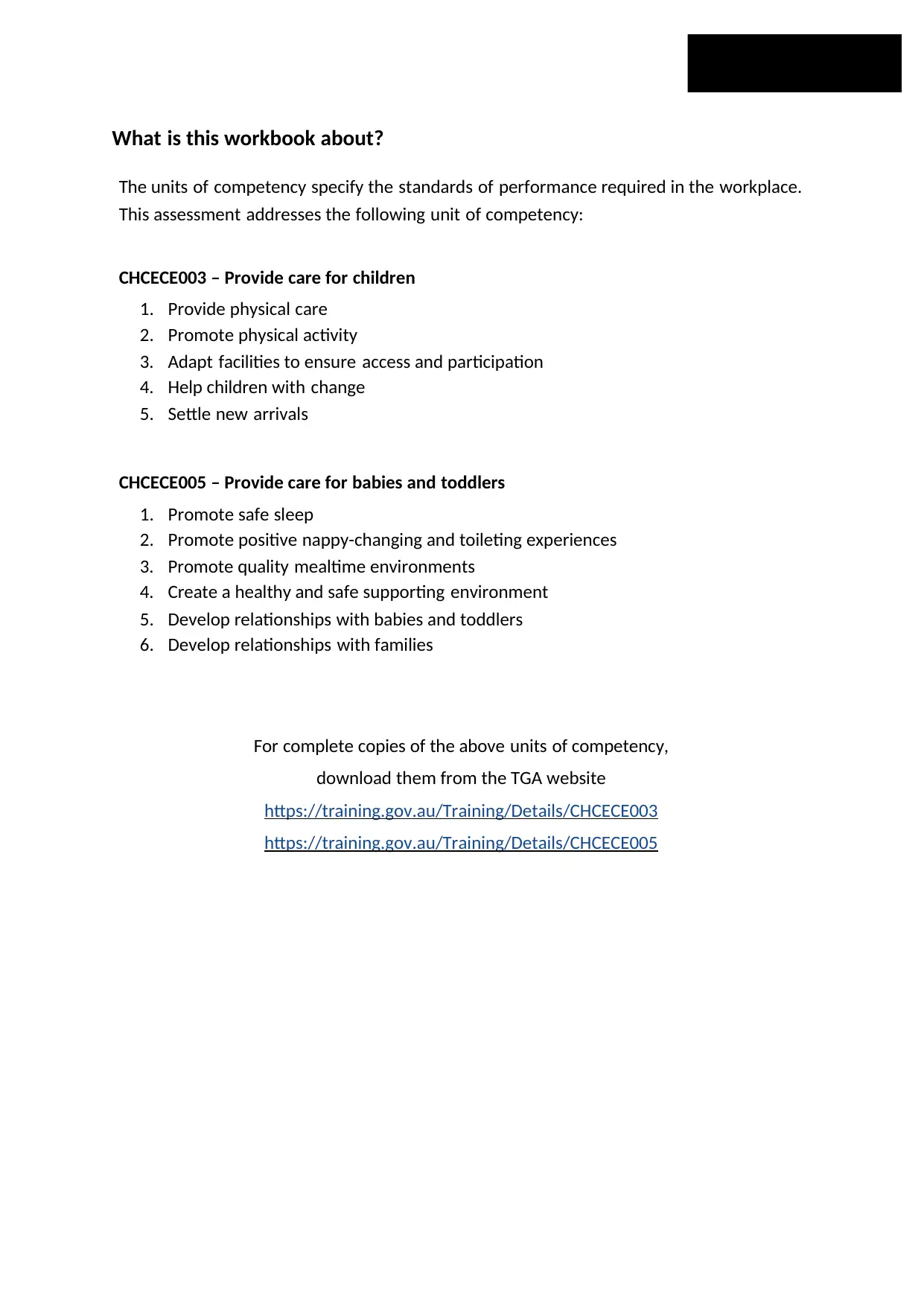
What is this workbook about?
The units of competency specify the standards of performance required in the workplace.
This assessment addresses the following unit of competency:
CHCECE003 – Provide care for children
1. Provide physical care
2. Promote physical activity
3. Adapt facilities to ensure access and participation
4. Help children with change
5. Settle new arrivals
CHCECE005 – Provide care for babies and toddlers
1. Promote safe sleep
2. Promote positive nappy-changing and toileting experiences
3. Promote quality mealtime environments
4. Create a healthy and safe supporting environment
5. Develop relationships with babies and toddlers
6. Develop relationships with families
For complete copies of the above units of competency,
download them from the TGA website
https://training.gov.au/Training/Details/CHCECE003
https://training.gov.au/Training/Details/CHCECE005
The units of competency specify the standards of performance required in the workplace.
This assessment addresses the following unit of competency:
CHCECE003 – Provide care for children
1. Provide physical care
2. Promote physical activity
3. Adapt facilities to ensure access and participation
4. Help children with change
5. Settle new arrivals
CHCECE005 – Provide care for babies and toddlers
1. Promote safe sleep
2. Promote positive nappy-changing and toileting experiences
3. Promote quality mealtime environments
4. Create a healthy and safe supporting environment
5. Develop relationships with babies and toddlers
6. Develop relationships with families
For complete copies of the above units of competency,
download them from the TGA website
https://training.gov.au/Training/Details/CHCECE003
https://training.gov.au/Training/Details/CHCECE005
Paraphrase This Document
Need a fresh take? Get an instant paraphrase of this document with our AI Paraphraser
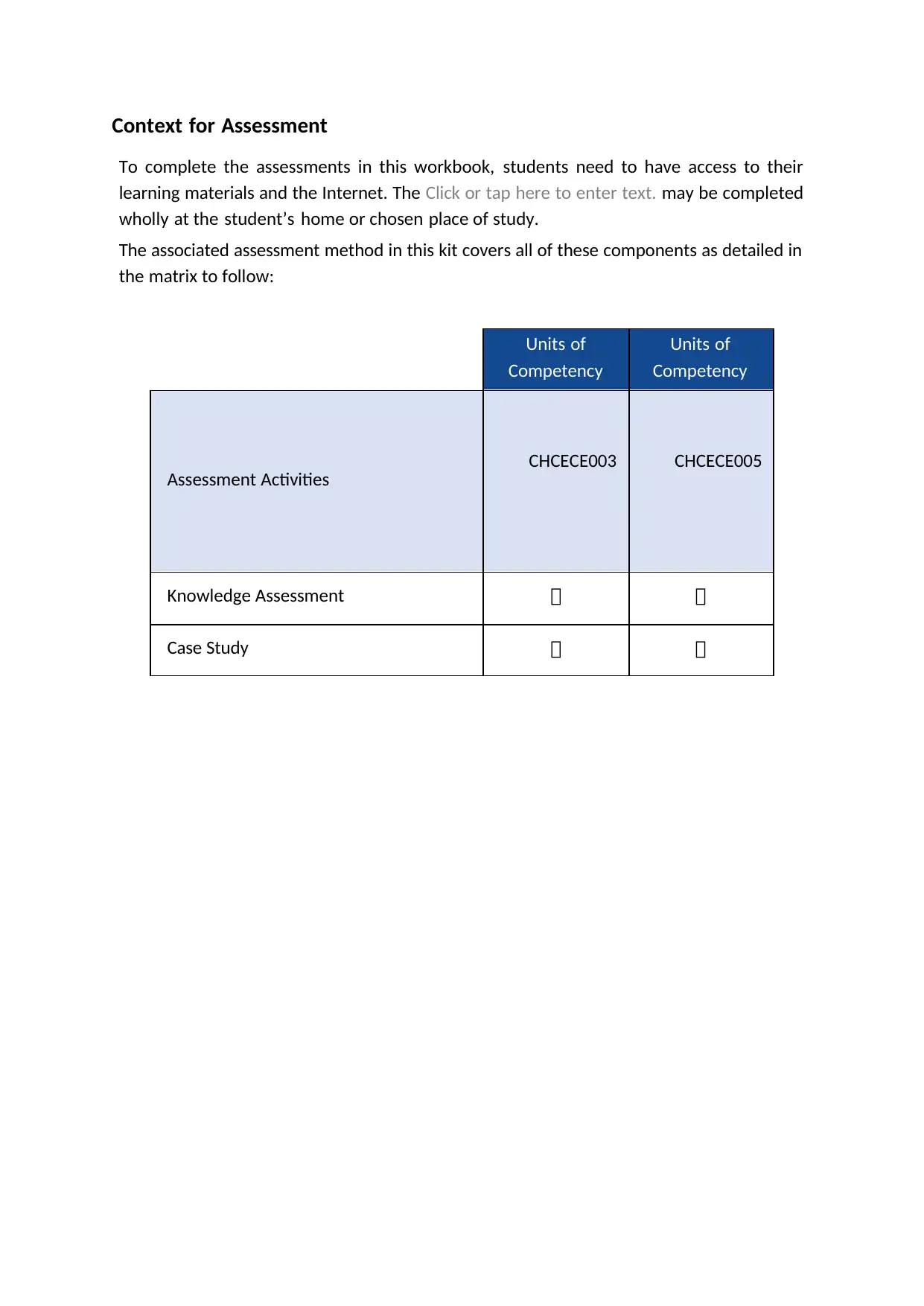
Context for Assessment
To complete the assessments in this workbook, students need to have access to their
learning materials and the Internet. The Click or tap here to enter text. may be completed
wholly at the student’s home or chosen place of study.
The associated assessment method in this kit covers all of these components as detailed in
the matrix to follow:
Units of
Competency
Units of
Competency
Assessment Activities CHCECE003 CHCECE005
Knowledge Assessment
Case Study
To complete the assessments in this workbook, students need to have access to their
learning materials and the Internet. The Click or tap here to enter text. may be completed
wholly at the student’s home or chosen place of study.
The associated assessment method in this kit covers all of these components as detailed in
the matrix to follow:
Units of
Competency
Units of
Competency
Assessment Activities CHCECE003 CHCECE005
Knowledge Assessment
Case Study

Assessment Methods
1. Knowledge Assessment - Written assessments to test students’ understanding of
underpinning knowledge, concepts and/or theories relevant to the units of
competency included in this subject.
2. Case Study - Detailed scenarios and simulated environments providing all necessary
information required to complete relevant tasks and activities.
Resources Required for Assessment
Assessor to provide:
Templates needed for tasks such as survey forms and report template.
Case studies and simulations
Information about work activities
You will need access to:
Office equipment and resources
Computer with internet access
Word processing computer program that can save and edit these file types:
○ MS Office Word file formats (documents)
○ PDF file format
A video recording device
Friend or family member to assist in minor role-play
1. Knowledge Assessment - Written assessments to test students’ understanding of
underpinning knowledge, concepts and/or theories relevant to the units of
competency included in this subject.
2. Case Study - Detailed scenarios and simulated environments providing all necessary
information required to complete relevant tasks and activities.
Resources Required for Assessment
Assessor to provide:
Templates needed for tasks such as survey forms and report template.
Case studies and simulations
Information about work activities
You will need access to:
Office equipment and resources
Computer with internet access
Word processing computer program that can save and edit these file types:
○ MS Office Word file formats (documents)
○ PDF file format
A video recording device
Friend or family member to assist in minor role-play
⊘ This is a preview!⊘
Do you want full access?
Subscribe today to unlock all pages.

Trusted by 1+ million students worldwide
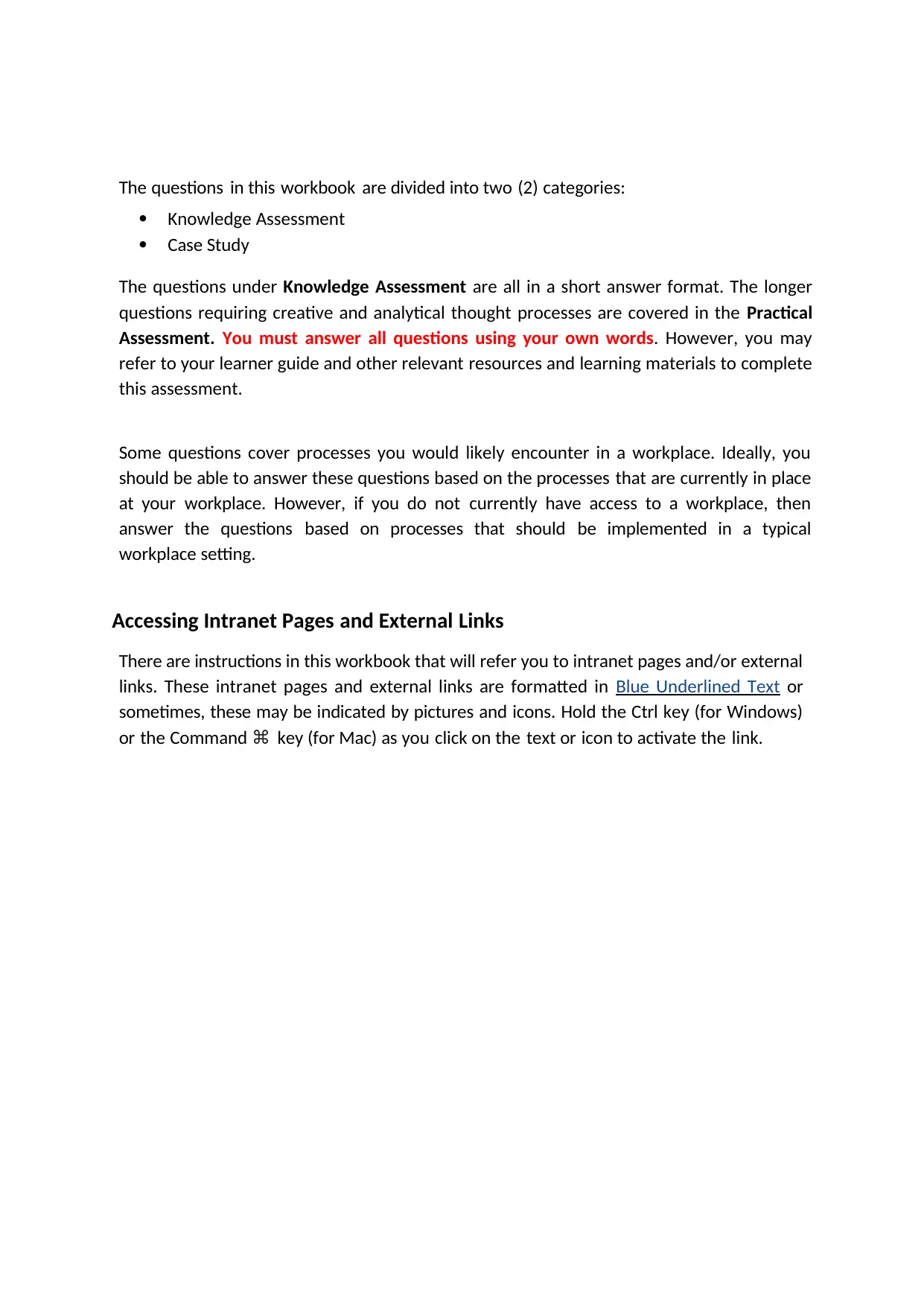
The questions in this workbook are divided into two (2) categories:
Knowledge Assessment
Case Study
The questions under Knowledge Assessment are all in a short answer format. The longer
questions requiring creative and analytical thought processes are covered in the Practical
Assessment. You must answer all questions using your own words. However, you may
refer to your learner guide and other relevant resources and learning materials to complete
this assessment.
Some questions cover processes you would likely encounter in a workplace. Ideally, you
should be able to answer these questions based on the processes that are currently in place
at your workplace. However, if you do not currently have access to a workplace, then
answer the questions based on processes that should be implemented in a typical
workplace setting.
Accessing Intranet Pages and External Links
There are instructions in this workbook that will refer you to intranet pages and/or external
links. These intranet pages and external links are formatted in Blue Underlined Text or
sometimes, these may be indicated by pictures and icons. Hold the Ctrl key (for Windows)
or the Command ⌘ key (for Mac) as you click on the text or icon to activate the link.
Knowledge Assessment
Case Study
The questions under Knowledge Assessment are all in a short answer format. The longer
questions requiring creative and analytical thought processes are covered in the Practical
Assessment. You must answer all questions using your own words. However, you may
refer to your learner guide and other relevant resources and learning materials to complete
this assessment.
Some questions cover processes you would likely encounter in a workplace. Ideally, you
should be able to answer these questions based on the processes that are currently in place
at your workplace. However, if you do not currently have access to a workplace, then
answer the questions based on processes that should be implemented in a typical
workplace setting.
Accessing Intranet Pages and External Links
There are instructions in this workbook that will refer you to intranet pages and/or external
links. These intranet pages and external links are formatted in Blue Underlined Text or
sometimes, these may be indicated by pictures and icons. Hold the Ctrl key (for Windows)
or the Command ⌘ key (for Mac) as you click on the text or icon to activate the link.
Paraphrase This Document
Need a fresh take? Get an instant paraphrase of this document with our AI Paraphraser
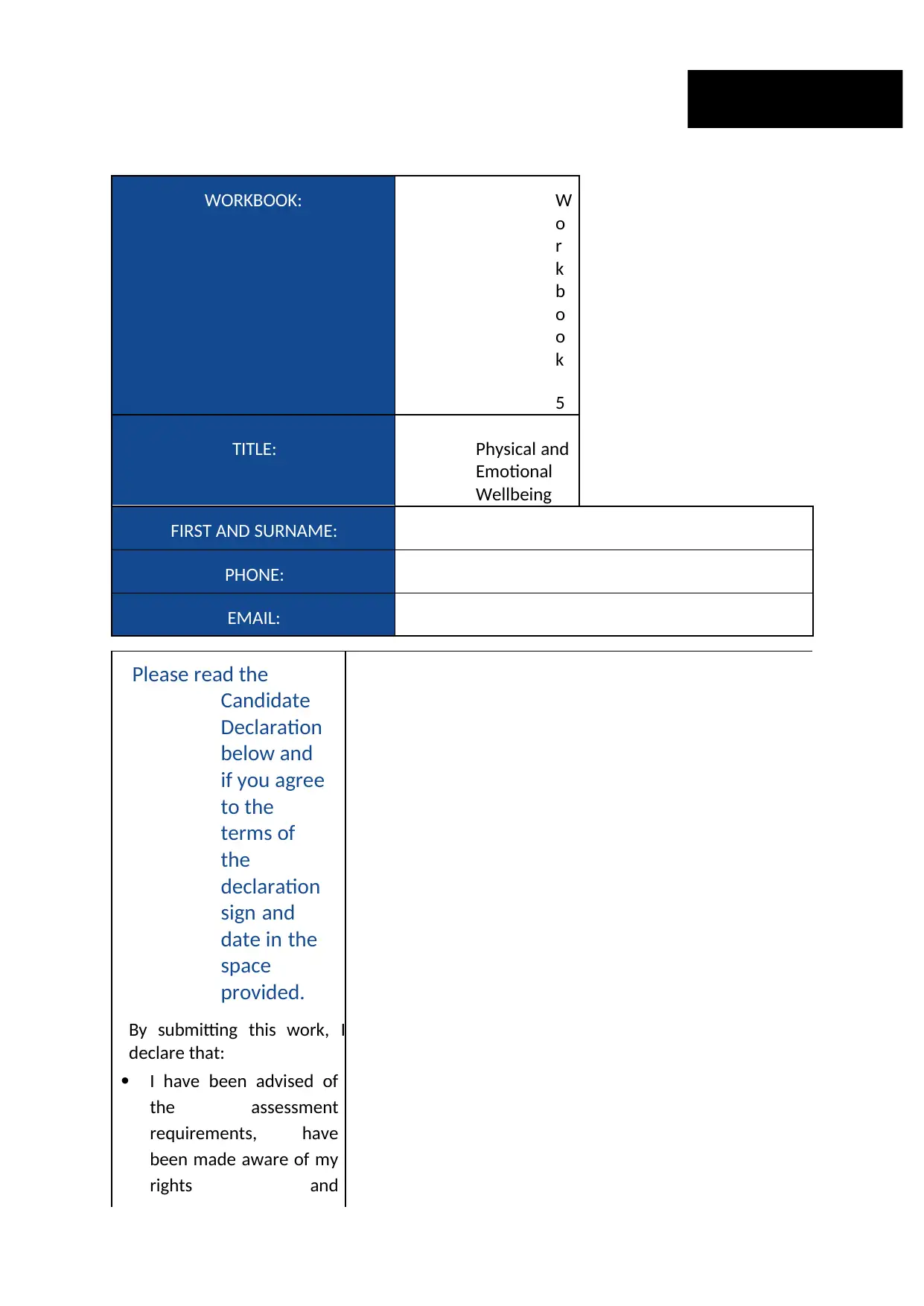
WORKBOOK: W
o
r
k
b
o
o
k
5
TITLE: Physical and
Emotional
Wellbeing
FIRST AND SURNAME:
PHONE:
EMAIL:
Please read the
Candidate
Declaration
below and
if you agree
to the
terms of
the
declaration
sign and
date in the
space
provided.
By submitting this work, I
declare that:
I have been advised of
the assessment
requirements, have
been made aware of my
rights and
o
r
k
b
o
o
k
5
TITLE: Physical and
Emotional
Wellbeing
FIRST AND SURNAME:
PHONE:
EMAIL:
Please read the
Candidate
Declaration
below and
if you agree
to the
terms of
the
declaration
sign and
date in the
space
provided.
By submitting this work, I
declare that:
I have been advised of
the assessment
requirements, have
been made aware of my
rights and

responsibilities as an
assessment candidate,
and choose to be
assessed at this time.
I am aware that there is
a limit to the number of
submissions that I can
make for each
assessment, and I am
submitting all
documents required to
complete this
Assessment Workbook.
I have organised and
named the files I am
submitting according to
the instructions
provided, and I am
aware that my assessor
will not assess work that
cannot be clearly
identified and may
request the work be
resubmitted according
to the correct process.
This work is my own and
contains no material
written by another
person except where
due reference is made. I
am aware that a false
declaration may lead to
the withdrawal of a
qualification or
statement of
attainment.
I am aware that there is
a policy of checking the
validity of qualifications
that I submit as evidence
assessment candidate,
and choose to be
assessed at this time.
I am aware that there is
a limit to the number of
submissions that I can
make for each
assessment, and I am
submitting all
documents required to
complete this
Assessment Workbook.
I have organised and
named the files I am
submitting according to
the instructions
provided, and I am
aware that my assessor
will not assess work that
cannot be clearly
identified and may
request the work be
resubmitted according
to the correct process.
This work is my own and
contains no material
written by another
person except where
due reference is made. I
am aware that a false
declaration may lead to
the withdrawal of a
qualification or
statement of
attainment.
I am aware that there is
a policy of checking the
validity of qualifications
that I submit as evidence
⊘ This is a preview!⊘
Do you want full access?
Subscribe today to unlock all pages.

Trusted by 1+ million students worldwide

as well as the
qualifications/evidence
of parties who verify my
performance or
observable skills. I give
my consent to contact
these parties for
verification purposes.
Name: Signature: Date:
qualifications/evidence
of parties who verify my
performance or
observable skills. I give
my consent to contact
these parties for
verification purposes.
Name: Signature: Date:
Paraphrase This Document
Need a fresh take? Get an instant paraphrase of this document with our AI Paraphraser
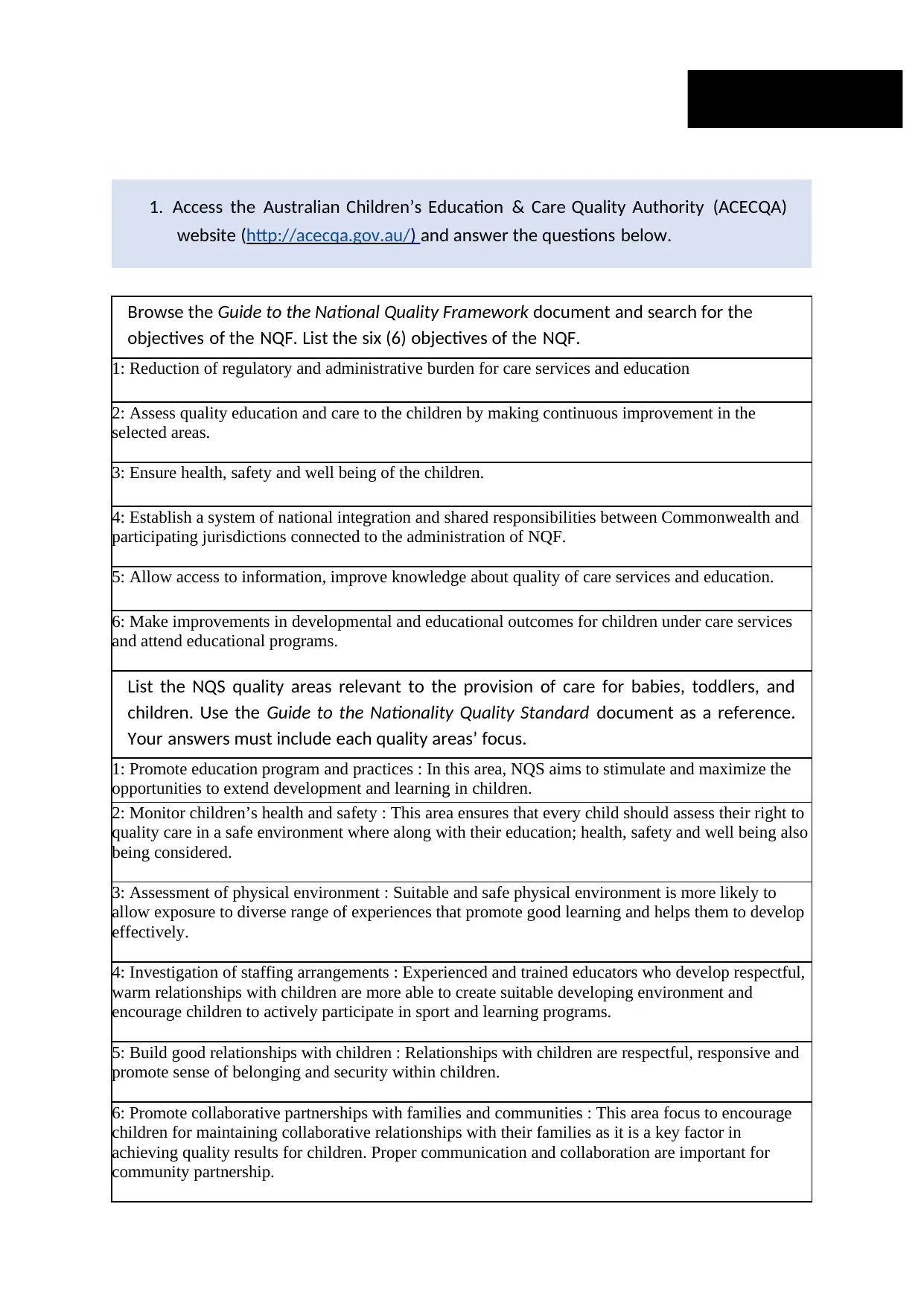
KNOWLEDGE ASSESSMENT
1. Access the Australian Children’s Education & Care Quality Authority (ACECQA)
website (http://acecqa.gov.au/) and answer the questions below.
Browse the Guide to the National Quality Framework document and search for the
objectives of the NQF. List the six (6) objectives of the NQF.
1: Reduction of regulatory and administrative burden for care services and education
2: Assess quality education and care to the children by making continuous improvement in the
selected areas.
3: Ensure health, safety and well being of the children.
4: Establish a system of national integration and shared responsibilities between Commonwealth and
participating jurisdictions connected to the administration of NQF.
5: Allow access to information, improve knowledge about quality of care services and education.
6: Make improvements in developmental and educational outcomes for children under care services
and attend educational programs.
List the NQS quality areas relevant to the provision of care for babies, toddlers, and
children. Use the Guide to the Nationality Quality Standard document as a reference.
Your answers must include each quality areas’ focus.
1: Promote education program and practices : In this area, NQS aims to stimulate and maximize the
opportunities to extend development and learning in children.
2: Monitor children’s health and safety : This area ensures that every child should assess their right to
quality care in a safe environment where along with their education; health, safety and well being also
being considered.
3: Assessment of physical environment : Suitable and safe physical environment is more likely to
allow exposure to diverse range of experiences that promote good learning and helps them to develop
effectively.
4: Investigation of staffing arrangements : Experienced and trained educators who develop respectful,
warm relationships with children are more able to create suitable developing environment and
encourage children to actively participate in sport and learning programs.
5: Build good relationships with children : Relationships with children are respectful, responsive and
promote sense of belonging and security within children.
6: Promote collaborative partnerships with families and communities : This area focus to encourage
children for maintaining collaborative relationships with their families as it is a key factor in
achieving quality results for children. Proper communication and collaboration are important for
community partnership.
1. Access the Australian Children’s Education & Care Quality Authority (ACECQA)
website (http://acecqa.gov.au/) and answer the questions below.
Browse the Guide to the National Quality Framework document and search for the
objectives of the NQF. List the six (6) objectives of the NQF.
1: Reduction of regulatory and administrative burden for care services and education
2: Assess quality education and care to the children by making continuous improvement in the
selected areas.
3: Ensure health, safety and well being of the children.
4: Establish a system of national integration and shared responsibilities between Commonwealth and
participating jurisdictions connected to the administration of NQF.
5: Allow access to information, improve knowledge about quality of care services and education.
6: Make improvements in developmental and educational outcomes for children under care services
and attend educational programs.
List the NQS quality areas relevant to the provision of care for babies, toddlers, and
children. Use the Guide to the Nationality Quality Standard document as a reference.
Your answers must include each quality areas’ focus.
1: Promote education program and practices : In this area, NQS aims to stimulate and maximize the
opportunities to extend development and learning in children.
2: Monitor children’s health and safety : This area ensures that every child should assess their right to
quality care in a safe environment where along with their education; health, safety and well being also
being considered.
3: Assessment of physical environment : Suitable and safe physical environment is more likely to
allow exposure to diverse range of experiences that promote good learning and helps them to develop
effectively.
4: Investigation of staffing arrangements : Experienced and trained educators who develop respectful,
warm relationships with children are more able to create suitable developing environment and
encourage children to actively participate in sport and learning programs.
5: Build good relationships with children : Relationships with children are respectful, responsive and
promote sense of belonging and security within children.
6: Promote collaborative partnerships with families and communities : This area focus to encourage
children for maintaining collaborative relationships with their families as it is a key factor in
achieving quality results for children. Proper communication and collaboration are important for
community partnership.

⊘ This is a preview!⊘
Do you want full access?
Subscribe today to unlock all pages.

Trusted by 1+ million students worldwide
1 out of 49
Related Documents
Your All-in-One AI-Powered Toolkit for Academic Success.
+13062052269
info@desklib.com
Available 24*7 on WhatsApp / Email
![[object Object]](/_next/static/media/star-bottom.7253800d.svg)
Unlock your academic potential
Copyright © 2020–2025 A2Z Services. All Rights Reserved. Developed and managed by ZUCOL.





